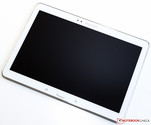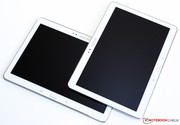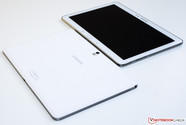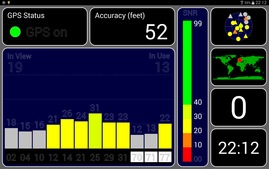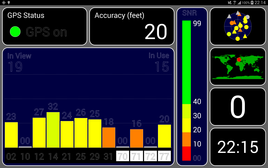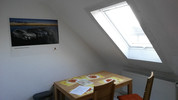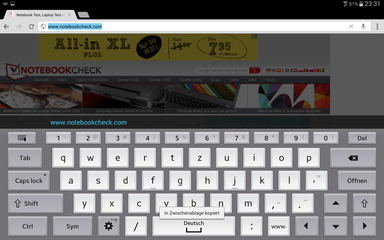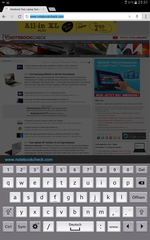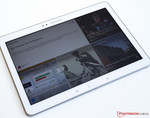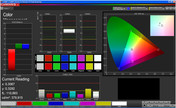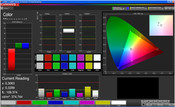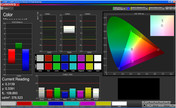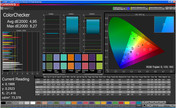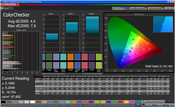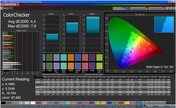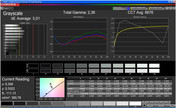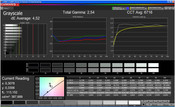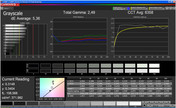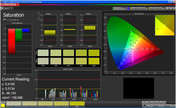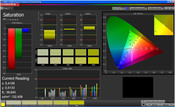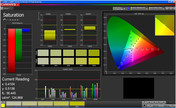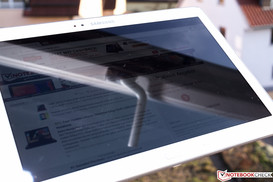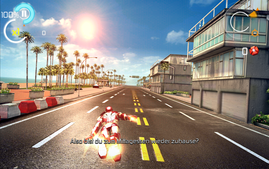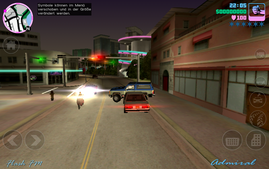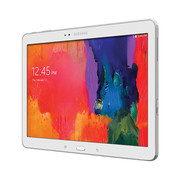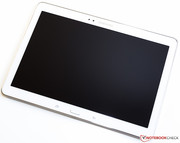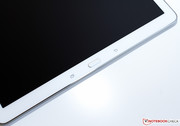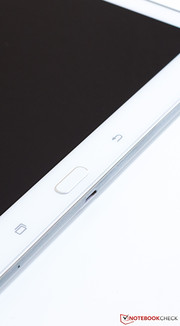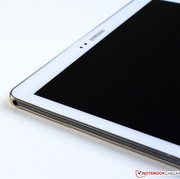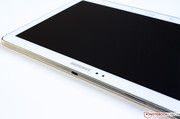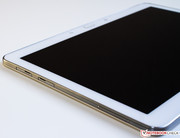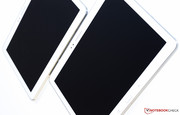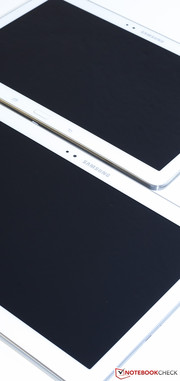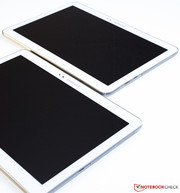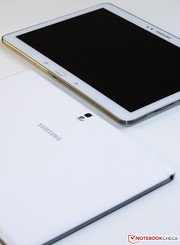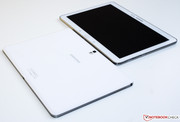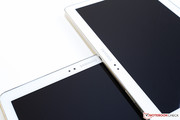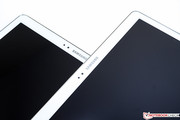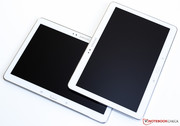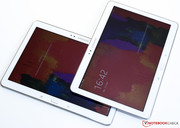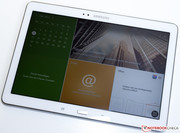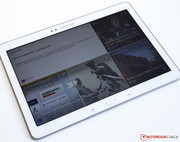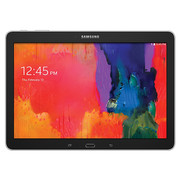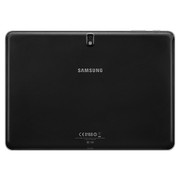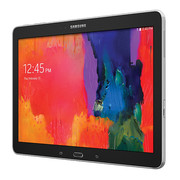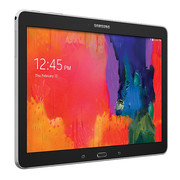Double-Review Samsung Galaxy Tab Pro 10.1 Tablet

For the original German review, see here.
We were actually pretty sure that Samsung would roll out the Galaxy Tab 4 line on the market this year, but the inventive marketing department opted for a new name. Both current models bear the name "Galaxy Tab Pro 10.1". We are curious as to what has been modified to such an extent that the tablets' name earns the add-on "Pro" compared with its precursors.
A significant difference is the choice of the SoC. The model that features LTE is powered by no other than Qualcomm's Snapdragon 800 quad-core with a clock rate of 2.3 GHz per core. Should mobile Internet outside a Wi-Fi network not be needed, the Wi-Fi-only model satisfies with the in-house Exynos 5420 octa-core. It uses the big.LITTLE technology, and features eight processing cores. Depending on the requirement, the tablet either falls back on four A15 cores (1.9 GHz per core) or uses A9 cores (1.3 GHz per core) for lower demands. Another upgrade compared with the precursor is found in the screen. Although it still has a size of 10.1 inches, it now has four-times the resolution (2560x1600 pixels). The next larger version is the Galaxy Note Pro 12.2. This high-end tablet also sports the Exynos 5420 octa-core. Whether buying a Galaxy Tab Pro 10.1 is worthwhile, and where the differences are exactly found, can be discovered in the following test report.
Case
The looks have barely changed at first glance. The display's bezel still features a brushed aluminum look, and slightly protrudes above the screen to prevent scratches. The back has a much higher quality feel because the polycarbonate is matte and textured. The tablet now features the same haptics as, for example, the Galaxy Note 3 or Galaxy Note 10.1. Both tested models only differ marginally from the outside - the biggest differences are found under the hood.
As expected from Samsung, everything features an immaculate build and makes a high quality impression. The casing is very stiff, and even lighter than that of the precursor (512 grams; ~18.1 oz), but it is almost as heavy as Apple's iPad Air (464 grams; ~16.4 oz). The octa-core model weighs 469 grams (~16.5 oz) and the LTE version weighs 477 grams (~16.8 oz). Compared with the new 12.2-inch edition (750 grams; ~25.4 oz) of the Galaxy Note Pro, our review sample is relatively light. With dimensions of 243.1 x 171.4 x 7.3 mm (~9.6 x 6.8 x 0.3 inches), it is slightly bigger than the iPad Air, and naturally much smaller than the 12.2-inch version (295.6 x 204 x 7.95 mm; ~11.6 x 8.0 x 0.3 inches).
Connectivity
As mentioned, both versions look nearly identical. One detail at the casing's right is however found. Only the Snapdragon 800 tablet has a micro-SIM slot. Like in the octa-core model, the right side also features the micro-SD slot and one speaker. Only a second speaker and the 3.5 mm jack for audio devices are found on the opposite side. The power button and volume rocker are located on the upper edge. The infrared port there enables using the tablet as a universal remote. The micro-USB port is on the lower edge. Users who want a USB 3.0 port will have to opt for the Galaxy Note 10.1 (2014) or Galaxy Note Pro 12.2.
Software
Both models feature Android 4.4.2. As expected, Samsung installs a lot of bloatware. Starting with "WebEx" over to "e-Meeting" up to "Hancom-Viewer" or the in-house developed "Samsung Apps" - there are quite a few pre-loaded apps. Many apps cannot be deleted, but they can be disabled.
Naturally, the launcher TouchWiz is a must in this tablet. Samsung has more tightly integrated the "MultiWindow" feature in the launcher, and either the latest messages or office applications are found left or right of the home screen. "S Voice" can be activated and used by double-clicking the home button.
Communication & GPS
One of the biggest differences is found in this sector. The model based on Qualcomm's SoC can set up connections to mobile Internet when out of reach of a wireless LAN network. The installed LTE module is responsible for this (800/850/900/1800/2600 MHz). However, should the mobile plan not include an LTE option, UMTS (850/900/1900/2100 MHz) can be used. We did not ascertain anything negative about the connection and transmission quality in the test period.
The Galaxy Tab 10.1 with an Exynos octa-core is worth looking at when such a module is not required. All other communication modules are identical. The Wi-Fi module supports the 802.11 a/b/g/n/ac standards, and can transmit in dual-band mode. The connection quality is also very good here, and there are no problems. Bluetooth version 4.0 is installed, and both models feature an infrared port on the tablet's upper edge.
The GPS module does a satisfactory job. The navigation aid was tested across the federal autobahns. Naturally, the sensor sooner or later lost the connection for a moment, but the sat-fix was quickly reestablished.
Cameras & Multimedia
The camera modules in both versions are also the same. The front-facing camera has a maximum resolution of 2 MPs, and the rear-facing unit has 8 MPs. An LED flash additionally supports the primary camera.
The camera on the tablet's back delivers good results in bright surroundings. The colors look natural, and the reproduction of details is largely satisfactory. The 2 MP camera displays the same scene a bit darker, but also surprises with a proper color reproduction. Of course, the pictures of the small unit exhibit considerably less detail, but this module will mainly be used for video calls. The indoor results are slightly inferior. Although everything can be recognized on pictures shot with the 8 MP camera, it is very obvious that the unit struggles with image noise at a very early stage. The front-facing camera underlines this observation even more. All in all, both cameras deliver quite useful results. The numerous photo modes of Samsung's software are noticed favorably. The manufacturer supplies a selection mode for almost every conceivable situation.
Accessories & Warranty
Considering the price of the Galaxy Tab Pro 10.1, the accessories are relatively sparse. Only a few sheets of paper about warranty terms and quick start instructions are found besides the modular power supply. No headset is included even for the LTE version.
The Galaxy Tab Pro comes with a 24-month warranty within the EU.
Input Devices & Controls
The screen responds to inputs made by up to ten fingers at the same time, and is both lightning fast and extremely accurate. The Galaxy Tab Pro needs a second before it rotates the screen's content, but functions without stuttering.
The virtual keyboard takes up approximately 50% of the screen in landscape mode. The view is not quite as restricted in portrait mode. Other keyboards can be installed via third party apps. They often feature settings for the keyboard size and other options. Users who prefer small keyboards should look closer at the app "Minuum Keyboard". Unfortunately, this Galaxy Tab still does not support the S-Pen. Thus, inputs will be made almost exclusively over the touchscreen. Buyers who want the S-Pen should either take the brand new Galaxy Tab Pro 12.2 or look closer at the Galaxy Note line (also available in 10.1 inches).
Display
The biggest innovation compared with the Galaxy Tab 3 10.1 is surely the screen's resolution. It is now even four times as high with 2560x1600 pixels. The WQXGA screen is a Super Clear TFT LCD in 16:10 format, and has a pixel density of 298.9 ppi. The bigger Galaxy Tab Pro 12.2 features the same resolution, just like the older Nexus 10 from Google.
The screen's average brightness of 367.7 cd/m² is very satisfactory. Unfortunately, we have to deduct a point in illumination because 78% is simply too low. The contenders, in the case of the iPad Air, with an illumination of 90%, score much better here. The screen's contrast could also be higher, but it is prevented by the increased black level of 0.7 cd/m².
| |||||||||||||||||||||||||
Brightness Distribution: 78 %
Center on Battery: 380 cd/m²
Contrast: 543:1 (Black: 0.7 cd/m²)
ΔE ColorChecker Calman: 4.4 | ∀{0.5-29.43 Ø4.82}
ΔE Greyscale Calman: 4.52 | ∀{0.09-98 Ø5.1}
Gamma: 2.54
CCT: 6716 K
Following tradition, Samsung offers various color modes in its devices. Using CalMAN 5 software and our colorimeter, we ascertained that the "Standard" mode is the best compromise in color reproduction, color saturation, and grayscale reproduction. The average DeltaE rate of 4.95 (Color Checker) and 4.52 (Grayscale) underlines this. The extremely fluctuating grayscale reproduction quality in the "Dynamic" mode is very conspicuous. They are too bright in the darker part, and too dark in light gray hues. The "Video" mode is not completely convincing either because the "red" and "blue" colors are not rendered naturally.
A very high average brightness, a high contrast (resulting from a low black level), and an anti-glare screen is needed to achieve the full score in this segment. Unfortunately, few tablets currently on the market feature a matte screen. An appropriate screen protector can help here. Although the contrast of 543:1 is at an acceptable level, a lower black level could lead to a clearly better result. Using the Tab Pro 10.1 outdoors is possible, in general, by playing with the viewing angles a bit, and making sure that the sun does not shine directly on the screen.
Performance
The first major difference to the Galaxy Tab 3 10.1 was the screen's resolution. The second is found here in performance and the installed hardware; the difference within the Galaxy Tab 10.1 line is just as striking. The tablet is available in two different versions. When opting for the SoC from Qualcomm, the quad-core model is the Snapdragon 800 (8974-AA) and has a clock frequency of 2.3 GHz per core. It is an old acquaintance among the SoCs. This version is only sold with an installed LTE module.
The second version of the review sample is more interesting. The long-awaited octa-core Exynos 5420 from Samsung is installed here. This SoC consists, in the proper sense, of two separately working quad-cores, and operates according to the ARM big.LITTLE concept. The processing cores built in the 28 nm process are used according to the performance demand. For example, high performance demand is processed by the ARM Cortex A15 cores (1.9 GHz per core), and are disabled when the tablet is idling. Then the ARM Cortex A7 cores (1.2 GHz) power the tablet. The ARM Mali-T628 graphics solution is used as the GPU. The SoCs of both versions fall back on 2 GB of working memory.
We particularly noticed that the performance of the Galaxy Note Pro 12.2 is on a very similar level in the synthetic benchmarks. That is unsurprising since the SoC is identical, and the device's other equipment only differs from the smaller 10.1-inch version in certain points. Older tablets, such as Sony's Xperia Tablet Z or Google's Nexus 10, can only compete in a few benchmarks - these two models often lag far behind. The very high performance of Apple's iPad Air remains outstanding. Regardless whether it is the 10.1-inch or the 12.2-inch version of the Galaxy Tab Pro, both tablets have a hard time reaching the performance of Apple's flagship.
| 3DMark | |
| 1280x720 offscreen Ice Storm Unlimited Physics (sort by value) | |
| Samsung Galaxy Tab Pro 10.1 WiFi-Version | |
| Samsung Galaxy Tab Pro 10.1 LTE-Version | |
| Apple iPad Air 1 2013 | |
| 1280x720 offscreen Ice Storm Unlimited Graphics Score (sort by value) | |
| Samsung Galaxy Tab Pro 10.1 WiFi-Version | |
| Samsung Galaxy Tab Pro 10.1 LTE-Version | |
| Apple iPad Air 1 2013 | |
| 1280x720 offscreen Ice Storm Unlimited Score (sort by value) | |
| Samsung Galaxy Tab Pro 10.1 WiFi-Version | |
| Samsung Galaxy Tab Pro 10.1 LTE-Version | |
| Apple iPad Air 1 2013 | |
Apple again has the lead in the browser-based benchmarks - with both its iPad Air and iPad Mini Retina. Not much has changed in performance compared with the Xperia Tablet Z or Nexus 10 either, although both older models come a bit closer to our review sample. Microsoft's Surface 2 and the Lumia 1520, as representatives of the Microsoft division, often have a hard time. The score is clearly in favor of the Windows devices only in the "Sunspider" benchmark.
* ... smaller is better
A mixed impression is conveyed in the storage speed assessment. The Galaxy Note Pro 12.2 is most conspicuous because it scores poorer than our review sample in three of four tests. Just as surprising is that the Nexus 10 is permanently before the Galaxy Tab Pro 10.1 in sequential processes. Thus, the review sample is no rocket in regard to flash performance, but it is not slow either.
Games & Videos
The hardware faces a challenge that should not be underestimated when rendering videos. We already checked whether the Snapdragon 800 SoC has problems with playing QFHD videos in earlier tests - which was not the case. It did not have problems with rendering current 3D games from Google's Play Store either.
The octa-core still has to pass this test, but we have a few doubts because the hardware is not cleared for QFHD videos. Its performance was examined based on various trailers. Unfortunately, our test video could only be rendered by using a third party player. The soundtrack worked perfectly, but the video track caused extreme artifacts, and did not run smoothly. Regrettably, the SoC cannot overcome this hurdle. In return, Full HD videos, and all kinds of 3D games were rendered without problems. The A15 cores of the Exynos 5420 have enough performance reserves to render all game contents smoothly and flawlessly.
Temperature
Different performance = different temperatures. The octa-core's average load temperature is approximately 31 °C (87.8 °F) (Apple iPad Air: 34.4 °C; 93.92 °F), and the Snapdragon 800 version's average is 30.2 °C (86.36 °F). The ascertained rates drop considerably when under no or only low load. The Tab Pro 10.1 with the Exynos octa-core reaches an average of 28.6 °C (93.48 °F) on the front in this case (Apple iPad Air: 30 °C; 86 °F) and 27.4 °C (81.32 °F) on the back. The model with the Qualcomm processor unit achieves similar rates (front: 28.2 °C; 82.76 °F; back: 28.5 °C; 83.3 °F). The difference between both devices is barely noticed, and the temperature difference compared with the Galaxy Note Pro 12.2 is also only marginal. We ascertained a maximum temperature of just over 44 °C (111.2 °F) on the power supplies of both tablets. That drops by about 4 °C (~7 °F) as soon as the two devices are put in idle mode.
Samsung Galaxy Tab Pro 10.1 WiFi-Version
(+) The maximum temperature on the upper side is 38.2 °C / 101 F, compared to the average of 33.7 °C / 93 F, ranging from 20.7 to 53.2 °C for the class Tablet.
(+) The bottom heats up to a maximum of 36.6 °C / 98 F, compared to the average of 33.2 °C / 92 F
(+) In idle usage, the average temperature for the upper side is 28.6 °C / 83 F, compared to the device average of 30 °C / 86 F.
Samsung Galaxy Tab Pro 10.1 LTE-Version
(+) The maximum temperature on the upper side is 35.6 °C / 96 F, compared to the average of 33.7 °C / 93 F, ranging from 20.7 to 53.2 °C for the class Tablet.
(+) The bottom heats up to a maximum of 35.7 °C / 96 F, compared to the average of 33.2 °C / 92 F
(+) In idle usage, the average temperature for the upper side is 28.8 °C / 84 F, compared to the device average of 30 °C / 86 F.
Speakers
The stereo speakers of both tablets are identical. We appreciated that the speakers are located on the casing's left and right edge. Thus, the openings are only covered in exceptional situations, and the sound does not distort, as is the case in many smartphones and tablets. The maximum volume is sufficient, but music is unlikely to be enjoyed at this level because the sound is not exempt from distortions. The sound of both tablets is impressive up to about 80% of the maximum volume. Users who nevertheless want a better sound can connect external speakers via the 3.5 mm jack. Providing the corresponding infrastructure is available, wireless streaming via Bluetooth 4.0 is possible. Samsung does not include a headset.
Energy Management
Power Consumption
Qualcomm's SoC clocks by up to 400 MHz higher per core than the Exynos 5420. This difference of course has a direct impact on the full load power consumption - one might think. The Snapdragon 800 model consumes between 9.1 and 11. 2 Watts under load. Surprisingly, the Exynos version drains between 10.1 and 11.2 Watts from the battery. A difference is seen in low performance operations. The big.LITTLE technology can display its advantage here because the requirement ranges from 2.9 to 8 Watts. The consumption of the Snapdragon model drops between 3.5 and 8.9 Watts in the idle scenario. The consumption when deactivated is an unpleasant surprise because both tablets consume 1.2 Watts.
Samsung Galaxy Tab Pro 10.1 WiFi-Version
| Off / Standby | |
| Idle | |
| Load |
|
Key:
min: | |
Samsung Galaxy Tab Pro 10.1 LTE-Version
| Off / Standby | |
| Idle | |
| Load |
|
Key:
min: | |
Battery Runtime
Even if both models do a similarly good job, the biggest difference will likely be ascertained in the battery runtime. It became clear in the previous section that both models require a different amount of energy. A clear recommendation cannot be given here because the tablet powered by the Snapdragon 800 SoC achieves an outstanding full load runtime, while the octa-core model exhibits its advantages in idle applications. The LTE version accomplished an awesome full load runtime of 6 hours and 5 minutes. The Wi-Fi version was drained after about half the time (3:38 hours). This is the opposite in our Wi-Fi test using a screen brightness of approx. 150 cd/m². The octa-core's architecture using four energy-efficient cores pays off because the review sample achieved a runtime of 14 hours and 45 minutes (LTE sample: 12:44 hours). This difference is even clearer when the screen's brightness is set to the absolute minimum and the wireless models are disabled. The octa-core consumes so little power that the tablet had to be recharged only after 21:55 hours. The Snapdragon tablet was drained almost 5 hours sooner. Both Galaxy Tab Pro 10.1 models are on a similar level as the iPad Air. The iPad Air is very lasting with an idle runtime of just under 24 hours. However, our review sample managed a better runtime in the Wi-Fi test. The non-removable battery in both cases has a capacity of 8220 mAh.
Samsung Galaxy Tab Pro 10.1 WiFi-Version
Samsung Galaxy Tab Pro 10.1 LTE-Version
Verdict
The Galaxy Tab 3 10.1 line has been replaced by the Galaxy Tab Pro 10.1 series. Not much has changed in terms of looks and size, and the build quality remains at a high standard. The biggest differences are surely the WQXGA screen with 2560x1600 pixels and the stronger SoC. Surprisingly, Samsung has decided to offer two processor versions. The well-known Snapdragon 800 quad-core (2.3 GHz per core) powers one, and Samsung's own Exynos 5420 octa-core (1.9 GHz) the other version. Drawbacks of the Exynos model are the unavailable LTE module, and the fact that the SoC cannot play QFHD videos.
Fundamentally, both models do not differ much, and a closer look is needed to find differences. The tablets feature high performance and good battery runtime at the same time - this combination is not a matter of course. Fused with a razor-sharp screen, a good camera, and numerous communication interfaces, the new devices of the Galaxy Tab Pro 10.1 line are true all-rounders. The LTE version, based on the Snapdragon 800 SoC, is currently available for 599 Euros (~$828 RRP), and the Exynos version without an LTE module sells for 499 Euros (~$690). Their prices will barely differ from the manufacturer's recommended price since both tablets are new on the market. It is difficult to recommend a specific device. In sum, the battery runtime and performance of the Qualcomm SoC is better, and it comes with an LTE module on top - however, it is also more expensive. Buyers who do not need this wireless module or want to play QFHD videos are very well advised with the Exynos model. Looking closely at the Galaxy Note Pro 12.2 would be worthwhile when 2 cm more are acceptable, and an S-Pen is a useful supplement. It is also available in two SoC versions.




